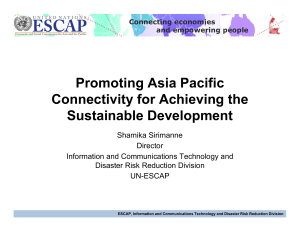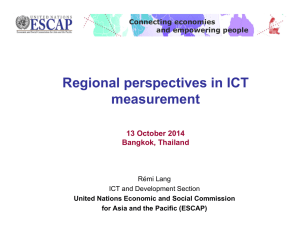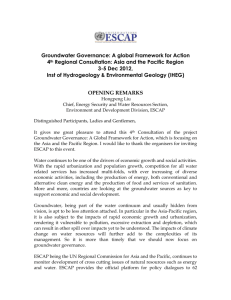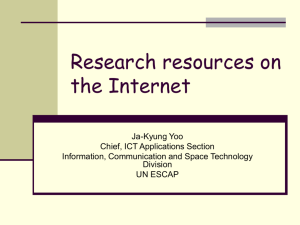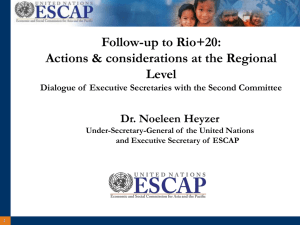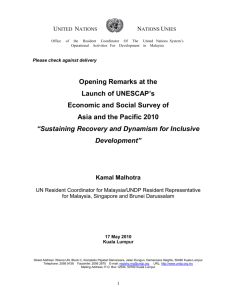The Asia Pacific information superhighway and The need for IXPs
advertisement
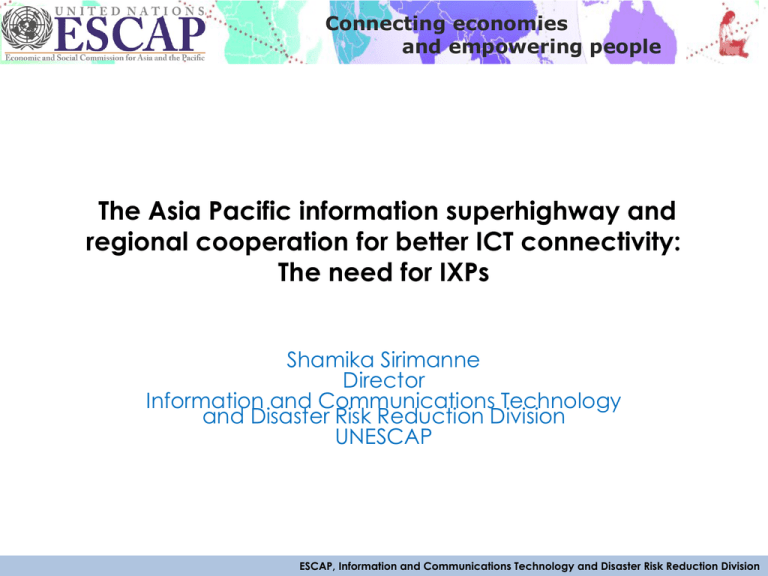
Connecting economies and empowering people The Asia Pacific information superhighway and regional cooperation for better ICT connectivity: The need for IXPs Shamika Sirimanne Director Information and Communications Technology and Disaster Risk Reduction Division UNESCAP ESCAP, Information and Communications Technology and Disaster Risk Reduction Division Connecting economies and empowering people ICT for Development • ICT plays a central role for sustainable development: • Development enhancing applications (e-education, e-health, business information etc.) • Enabling infrastructure (supports innovation, smart grids, intelligent transport systems) • ICT incorporated in MDGs and future SDGs (education, gender, infrastructure), • However, Asia-Pacific is the most digitally-divided region in World, with only 6% of Asia-Pacific developing population connected to high-speed Internet • This is in large part driven by cost of broadband. Cost of a monthly subscription to fixed broadband as a % of monthly GNI: • less than 1% in ESCAP developed countries • Over 18% in ESCAP developing countries (39% in LDCs, 46% in Pacific SIDS). Official target is 5% • Despite rapid progress in mobile broadband penetration, ESCAP developing countries are not catching up : risk of increasing digital divide ESCAP, Information and Communications Technology and Disaster Risk Reduction Division Connecting economies and empowering people Rising need for ICT infrastructure • Convergence of technologies requires increased connectivity, emergence of “Internet of Things” (IoT), intelligent transport systems (ITS) • Experts predict exponential growth in demand for broadband capacity (bandwidth), with the increased demand for usergenerated online content, video, cloud computing • Moreover, mobile broadband technology will increasingly require fiber network for traffic aggregation and antenna coordination • ADB estimated that between 2010-2020, the Asia-Pacific region needs to spend about US$ 800 billion for ICT infrastructure; • Regional coordination is required to improve ICT connectivity and increase interconnections between national networks: • Asia-Pacific information superhighway initiative to promote better ICT infrastructure for better connectivity ESCAP, Information and Communications Technology and Disaster Risk Reduction Division Connecting economies and empowering people Asia Pacific information superhighway initiative • APIS concept defined after conduction of research and analysis that exposed gaps and need for better regional coordination in 4 sub-areas (4 pillars): 1. Physical infrastructure upgrade and interconnection 2. Internet traffic management 3. Building regional network resilience 4. Promoting broadband access in underserved areas • ESCAP carried out subregional in-depth studies on broadband infrastructure to explore causes of digital divide. Also reviewed existing connecting infrastructure by creating maps of transmission infrastructure • Results were presented and discussed with experts in respective subregions, and at the ESCAP ICT Committee • Resolution 71/10: ESCAP countries called for creation of open-ended Working Group on Asia Pacific information superhighway to move forward with implementation ESCAP, Information and Communications Technology and Disaster Risk Reduction Division Connecting economies and empowering people Theme 2: Improved Internet Traffic Management • To support user demand, industry recommendations call for countries to be able to deliver broadband capacities at 10 Mbps. • International internet traffic is affected by hair-pinning: data transits through far away 3rd countries (USA, EU), when travelling between 2 neighbouring ESCAP countries or even within single country. Resulting in higher costs and latency • Local caching, Internet Exchange Points (IXPs) part of solution Source: A Report on “A Pre-Feasibility Study on Conceptualization, International Traffic & Quality Analysis, Network Topology Design and Implementation Model for the Asian Pacific Information Superhighway in the ASEAN Sub-region”, ESCAP ESCAP, Information and Communications Technology and Disaster Risk Reduction Division Connecting economies and empowering people Insufficient IXPs in Asia Pacific • The Asia Pacific region lacks a sufficient number of IXPs to promote efficient traffic management and resilience. • Enhancing regional IXPs will enable better use of expensive international backhaul bandwidth (tier 1 connectivity). • The Asia Pacific Information Superhighway emphasizes that IXPs should be open access and non-discriminatory, to enable transparent network management promote trust. Source: http://www.datacentermap.com/ixps.html ESCAP, Information and Communications Technology and Disaster Risk Reduction Division Connecting economies and empowering people Insufficient Interconnectivity Increases Risk • The 2030 development agenda strongly emphasizes the need for resilient infrastructure to protect development gains and enhance socioeconomic growth. • The lack of interconnectivity between nation and international networks increases the risk of disconnection from the global internet. • In order to address this issue, additional physical interconnectivity, as well as IXPs and enhanced cooperation in network management is necessary. Source: Regional Connectivity Update, 2013, Renesys ESCAP, Information and Communications Technology and Disaster Risk Reduction Division Connecting economies and empowering people Theme 3: Reinforcing infrastructure resilience • Lack of alternative routes for Internet traffic puts countries at risk when incidents occur on transmission infrastructure • On August 14th, cut on the Kengtung-Myawaddy fibre-optic network between Myanmar and Thailand resulted in traffic disruption in Myanmar as this route is heavily used for international transit. Alternative routes (submarine and terrestrial) are required. • Creation of meshed network with multiple interconnections will reduce risk of severe disruptions • This will require regional dialogue to ensure additional links are built in a way that serve both commercial but also regional network resilience purposes ESCAP, Information and Communications Technology and Disaster Risk Reduction Division Connecting economies and empowering people Summary • The Asia Pacific Information Superhighway initiative will help member countries overcome the severe digital divide in the Asia Pacific region. • In addition to physical infrastructure, enhanced traffic management, through tools such as IXPs is vital. • The region is in great need of enhanced IXPs to promote resilience and reduce connectivity costs. ESCAP, Information and Communications Technology and Disaster Risk Reduction Division Connecting economies and empowering people THANK YOU ESCAP, Information and Communications Technology and Disaster Risk Reduction Division
